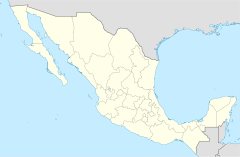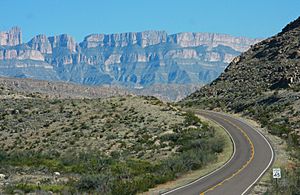Maderas del Carmen facts for kids
Quick facts for kids Maderas del Carmen |
|
|---|---|
|
IUCN Category VI (Managed Resource Protected Area)
|
|
| Area | 208,381 ha (804.56 sq mi) |
| Designation | Flora and fauna protection area and biosphere reserve |
| Designated | 1994 (flora and fauna protection area) and 2006 (biosphere reserve) |
| Administrator | National Commission of Natural Protected Areas |
Maderas del Carmen is a special natural area in the northern Mexican state of Coahuila. It is known as a biosphere reserve. This means it's a place where nature is protected, but people also live and work there. The goal is to find a balance between humans and nature.
This reserve covers part of the Sierra del Carmen mountains. These mountains are a northern part of the larger Sierra Madre Oriental range. Maderas del Carmen has two main types of land. It has dry, desert-like areas called Chihuahuan Desert shrublands. It also has cooler, higher-up places called "sky islands." These sky islands are like forests on top of mountains. They are home to pine and oak trees.
The reserve is full of amazing wildlife. You can find about 400 different kinds of birds here. There are also 70 types of mammals. Some of these include the American black bear (Ursus americanus), the collared peccary (Pecari tajacu), and the cougar (Puma concolor).
Maderas del Carmen was officially made a biosphere reserve in 2006. It is located across three different areas called municipalities. These are Ocampo, Ciudad Acuña, and Múzquiz.
Protecting Nature: Maderas del Carmen's Efforts
The Sierra del Carmen mountains are quite isolated. This means they are far from big cities and human activity. Because of this, the environment here is mostly untouched. This has led to many efforts to protect the area. Both Mexico and the United States work together on these efforts.
Much of the Sierra del Carmen is a "Flora and Fauna Protected Area." The Mexican government gave it this special title. This title allows some farming and private land ownership to continue. But it also helps protect the plants and animals. This protected area covers about 210,326 hectares (which is about 519,726 acres).
Maderas del Carmen is part of a bigger project. It's called the El Carmen—Big Bend Conservation Corridor Initiative. This project connects protected lands on both sides of the border. Together, these lands cover more than 12,000 square kilometers (about 3 million acres). That's almost as big as the U.S. state of Connecticut! In 2005, Maderas del Carmen became the first official Wilderness area in Latin America. A wilderness area is a place kept as wild as possible.
The Maderas del Carmen Protected Area was created in 1994. At first, conservation was slow. This was because much of the land was privately owned. It was either large ranches or collective farms called ejidos. In 2000, a Mexican company called Cementos de Mexico (CEMEX) started buying land in the region. They bought it specifically for conservation. On CEMEX lands, they removed farm animals and fences. They also encouraged native plants to grow back. By 2006, CEMEX owned or managed a large part of the land in the reserve. In 2009, the Mexican government created another protected area. It's called the Ocampo Flora and Fauna Protection Area. This area is right next to Maderas del Carmen.
One very important thing about the Sierra del Carmen is that it acts like a "corridor." This means it's a natural pathway for animals. They can travel north and south through it. For example, in the late 1980s, black bears used this corridor. They moved north from the Sierra into the mountains of west Texas. This helped them return to Big Bend National Park. Black bears had disappeared from west Texas in the 1950s.
There are other cool projects too. In 2000, CEMEX worked with conservation groups. They started breeding bighorn sheep. These sheep had been gone from the Sierra del Carmen for over 50 years. They are now being released back into the wild.
On October 24, 2011, Mexico and the United States signed an agreement. It was about working together to protect the Big Bend-Rio Bravo area. This shows how important this region is to both countries.
In 2020, something special happened. Nineteen plains bison were brought here. They came from the Janos Biosphere Reserve. This created the second wild bison herd in Mexico. The El Carmen nature reserve was set up on the plains of Coahuila for them.
See also
 In Spanish: Área de protección de flora y fauna Maderas del Carmen para niños
In Spanish: Área de protección de flora y fauna Maderas del Carmen para niños
- Mexico–United States international park



